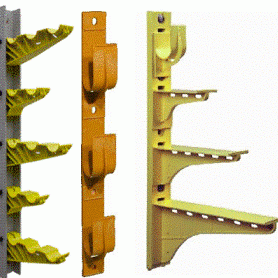How to Choose a Cable Rack for the Electrical Vaults and Man Holes
 First, you need to decide if you want to use the traditional galvanized steel cable racks or plastic cable racks which are the new standard in underground cable organization. There are several benefits to using a plastic cable support system. Plastic is not conductive, so there is no reason for grounding or bonding. It will not rust or corrode and lasts longer over time. It is especially good for damp underground environments. Since the plastics used to make cable racks are not sharp or abrasive on the cable jacket, no abrasion guards are necessary. These features make plastic cable racks faster to install and safer to work with. Different plastic material is used, depending on how much load the rack will need to carry. Cable racks are made of glass-filled polymer or polycarbonate.
First, you need to decide if you want to use the traditional galvanized steel cable racks or plastic cable racks which are the new standard in underground cable organization. There are several benefits to using a plastic cable support system. Plastic is not conductive, so there is no reason for grounding or bonding. It will not rust or corrode and lasts longer over time. It is especially good for damp underground environments. Since the plastics used to make cable racks are not sharp or abrasive on the cable jacket, no abrasion guards are necessary. These features make plastic cable racks faster to install and safer to work with. Different plastic material is used, depending on how much load the rack will need to carry. Cable racks are made of glass-filled polymer or polycarbonate.
Fixed Position Molded Racks
The next factor to consider is whether you need cable support configured to meet the project requirements or whether a fixed position style will serve your purpose the best. Some racks are molded in one piece with fixed position hooks to support a lighter load of cables. These less expensive racks are called Saddle Racks. They are used for power or communication installations in temporary or permanent applications. The cables are trained, organized, and well supported against the wall. Unless specified otherwise, at least two triple hook saddle racks should be installed parallel on a manhole wall. And at least one spare hook shall be available at each cable saddle rack position for future cable installations. Saddle racks are available in 1, 2, or 3 hook versions with a 2” or 3″ throat opening. Saddle racks are made from polycarbonate material. To be used in an electrical vault, the material must be non-halogenated; i.e., the material can not contain any bromides or other elements that could generate highly toxic halogen gas. And the material must comply with VO@.240 flammability requirements of UL94.
Racks for Metal or Non-Metal Stanchions
Some vaults have stanchions built into the concrete wall. Or you may be retrofitting an old metal racking system. So you will need a cable support system with arms that can be attached to these metal stanchions. But for a contractor to stock two types of cable racking systems is cumbersome. So there is a versatile racking system with arms that will attach to non-metal or metal stanchions. Each arm is easily secured with a single polymer pin, allowing for installing and removing the arms without disturbing adjacent installed cables. And with the arm conveniently pivoting on this one pin, the electrician can lift the cable support arm out of the way to work on lower cables. Due to the extreme strength and rigidity of the glass-filled polymer stanchions, installations require only two bolts to secure a stanchion to the wall. A cable tie can be run through the hole in the arm to secure the cable. This cable support system has loading capacities comparable to similar steel cable racks.
Racks for Heavy Loads
Heavy-duty cable racks are the new standard in versatile manhole racking. They also have a loading capacity comparable to steel cable racks. These heavy-duty racks are molded from Glass Reinforced Polymer. This heavy-duty racking system offers nine (9) stanchions and ten (10) arms of varying lengths and configurations. The arms are easily engaged with the stanchion at the rectangular holes molded on the front face of the stanchion. It is easy to visually determine if an arm is fully seated when the top surface of an arm is aligned with the top of the corresponding stanchion frame. Cable tie slots are located on the right rear of the stanchion. These cable tie slots may be used to secure small cables to the stanchion without the need for an arm. The cable tie slots may also be used to lock an arm in place. The heavy-duty stanchion incorporates a friction lock that secures the arms in the stanchions. The friction lock works well for applications with little upward force on the arm. A positive lock, catalog number HDL, is also available. The stanchions may be field cut to selected lengths with a carbide-tipped cut-off saw, offering even more versatility. Field cuts should only be made at the frame breaks molded onto the front face of the stanchion.
So to summarize, cable racks made of plastic (polymers or polycarbonates) are non-conductive, non-corrosive, and not sharp or abrasive. This makes them a suitable choice over steel cable racks because they are faster to install and safer to work with. Plus, they will not cut or abrade the cable as it is pulled over them. The choice of which plastic rack is best for the job depends on how heavy the cable being supported is and if the rack needs to attach to an existing metal stanchion.


